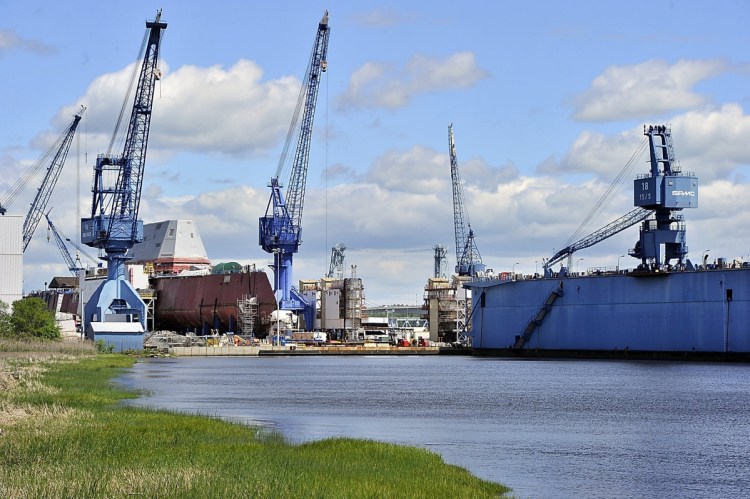Bath Iron Works has been awarded a $3.9 billion contract to build four additional DDG-51 Arleigh Burke-class guided missile destroyers, ensuring a robust workload for the Bath shipyard through 2022.
Still, BIW was bested by its primary competitor, Huntington Ingalls Industries of Pascagoula, Mississippi, which was simultaneously awarded a $5.1 billion contract to build six of the U.S. Navy destroyers. Typically, new contracts for Arleigh Burke-class destroyers have been split evenly between BIW and Huntington Ingalls.
At $3.9 billion for four destroyers, BIW is charging the Navy $975 million per vessel. In comparison, Huntington Ingalls’ $5.1 billion contract for six destroyers indicates that BIW’s top competitor is only charging $850 million per vessel.
BIW officials released a statement about the new contract late Thursday, but did not comment on the fact that it included two fewer ships than what the competition received.
“We are pleased with the opportunity for Bath Iron Works to continue our operation in the DDG-51 program and to deliver much-needed capability to our U.S. Navy customer,” BIW President Dirk Lesko said in the statement. “We would like to thank the entire Maine delegation for their support for both Navy shipbuilding and BIW, and specifically for recognizing the importance of the Arleigh Burke-class destroyers for our nation’s security.”
Maine’s congressional delegation issued a joint statement Thursday night praising the contract announcement.
“We are proud of the hardworking and highly skilled men and women at Bath Iron Works who have earned the reputation that ‘Bath built is best built,’ ” said the statement attributed to Sens. Susan Collins and Angus King, and Reps. Chellie Pingree and Bruce Poliquin. “The award of these four ships over the next five years, including the potential for additional ships, demonstrates the Navy’s recognition of the high-quality destroyers BIW produces that are critical to our national security. At a time when threats to our nation are increasing, we will continue to push for an aggressive rate of growth for large surface combatants to ensure our nation’s sailors have the resources they need to carry out their national security missions.”
The BIW contract, which involves building one ship per year from 2019 through 2022, allows for up to an additional $130 million in revenue if certain options are exercised. The Huntington Ingalls contract allows for up to an additional $150 million in revenue.
The awarded destroyers would keep BIW roughly at the same rate of production of Arleigh Burke-class destroyers in recent years. With the completion of the third and final Zumwalt-class “stealth destroyer” in sight, however, the shipyard is looking for a new contract that can replace that work.
To that end, the company has placed a bid to build the Navy’s new frigate. If BIW were to win the bid, it could give the shipyard up to 20 additional ships to build in the coming years.
With procurement for those vessels starting in 2020, the shipyard would be producing two ships per year in addition to the Arleigh Burke-class destroyers.
In May, the Navy announced that it would extend the service life of Arleigh Burke-class destroyers to 45 years to achieve a 355-ship Navy over the next 30 years. The extension will increase the service life of the DDG-51 destroyers by five to 10 years, depending on the ship.
The Arleigh Burke-class destroyer has been the core of BIW’s production for decades. The shipyard has been building the destroyers almost continuously since 1988. The program was halted briefly in the mid-2000s with the intention of replacing the ships with the highly advanced Zumwalt-class destroyers.
Faced with higher costs and difficulties of incorporating new technologies into the stealth destroyers, the Navy quickly backtracked, however, and in 2009 announced that it would be limiting production of Zumwalt-class destroyers to just three ships and resuming production of the Arleigh Burke-class destroyers, albeit with some updates.
Production of all three Zumwalt-class destroyers was awarded to BIW, with two now completed and the third currently being built.
In July, the Navy announced that the second Zumwalt-class destroyer, the $7.5 billion USS Michael Monsoor, needed a $20 million engine replaced because inspectors found damage after the ship’s naval acceptance trials.
Both the Monsoor and its predecessor, the USS Zumwalt, have sustained a variety of mechanical problems.
Crew members on the Zumwalt found a seawater leak in a lubrication system for one of the ship’s propeller shafts in September 2016, less than a month after the ship left Bath.
In November 2016, the ship suffered another mechanical breakdown, requiring that it be towed to a port in the Panama Canal. It was transiting the canal when it lost propulsion in one of its two drive shafts, and crew members noticed water coming into bearings connecting the shaft with its electric motor.
The Monsoor had to cut short its first sea trials because of an electrical system failure the day after it left BIW in December. The failure during the ship’s builder trials prevented workers from testing propulsion and electrical systems at full power. The ship returned to the shipyard under its own power, and it returned to sea after the problem was resolved.
Shipbuilding experts have said major mechanical failures are common occurrences among the first few members of a new class of ships, particularly ships outfitted with cutting-edge technology such as the Zumwalt class.
Times Record Staff Writer Nathan Strout contributed to this report.
J. Craig Anderson can be contacted at 791-6390 or at:
Twitter: @jcraiganderson
Send questions/comments to the editors.




Comments are no longer available on this story